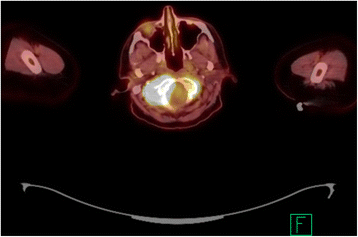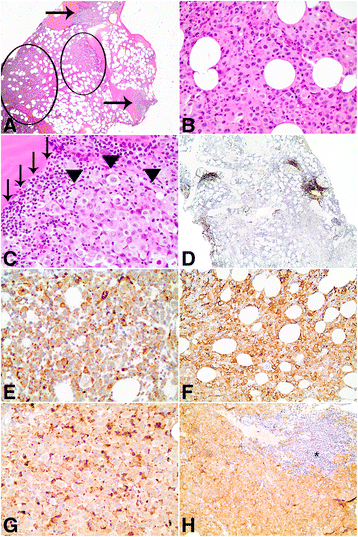BRAF V600E expression in histiocytic sarcoma associated with splenic marginal zone lymphoma: a case report
- PMID: 28376906
- PMCID: PMC5381012
- DOI: 10.1186/s13256-017-1253-z
BRAF V600E expression in histiocytic sarcoma associated with splenic marginal zone lymphoma: a case report
Abstract
Background: Histiocytic sarcoma is a rare histiocytic neoplasm of unknown etiology that constitutes less than 1% of hematologic malignancies. A few cases of histiocytic sarcoma harboring the BRAF V600E mutation have been reported, but this finding has not been confirmed in all studies.
Case presentation: We report the case of a 63-year-old white woman with a history of splenic marginal zone lymphoma who presented with 2 weeks of right-sided neck swelling. Positron emission tomography revealed an intensely hypermetabolic and destructive soft tissue mass in her right skull base. A bone marrow biopsy was performed, which revealed an infiltrate of malignant cells characterized as large pleomorphic cells with frequent folded/irregular nuclei, variably prominent nucleoli, fine chromatin, and abundant amounts of eosinophilic cytoplasm. The malignant cells were positive for CD163, CD68 (granular), lysozyme (granular), CD4, and CD45 (partial). Based on the biopsy findings, she was diagnosed as having histiocytic sarcoma. The malignant cells tested positive for the BRAFV600E protein using immunohistochemistry. Before treatment of her histiocytic sarcoma could be initiated, she developed disseminated intravascular coagulation and acute hypoxemic respiratory failure secondary to non-cardiogenic pulmonary edema. She decided to pursue comfort care and died in our hospital 2 weeks following admission.
Conclusions: Our case illustrates the aggressive nature of histiocytic sarcoma, and provides rare evidence that histiocytic sarcoma associated with indolent lymphomas may harbor the BRAF V600E mutation. Further research is needed to clarify the role of targeted therapies such as vemurafenib in the treatment of patients with this disorder.
Keywords: Histiocytic sarcoma; Immunohistochemistry; Marginal zone B-cell lymphoma; Proto-oncogene proteins B-raf.
Figures



Similar articles
-
[Histiocytic sarcoma derived from the same origin as splenic marginal zone lymphoma revealed by exome analysis].Rinsho Ketsueki. 2024;65(8):737-741. doi: 10.11406/rinketsu.65.737. Rinsho Ketsueki. 2024. PMID: 39231701 Japanese.
-
Evidence of BRAF V600E in indeterminate cell tumor and interdigitating dendritic cell sarcoma.Ann Diagn Pathol. 2015 Jun;19(3):113-6. doi: 10.1016/j.anndiagpath.2015.02.008. Epub 2015 Mar 5. Ann Diagn Pathol. 2015. PMID: 25787243
-
A Rare Case of Primary Histiocytic Sarcoma of the Stomach.Folia Med (Plovdiv). 2018 Jun 1;60(2):318-322. doi: 10.1515/folmed-2017-0075. Folia Med (Plovdiv). 2018. PMID: 30355826
-
A rare case of primary central nervous system histiocytic sarcoma harboring a novel ARHGAP45::BRAF fusion: a case report and literature review.Brain Tumor Pathol. 2024 Jan;41(1):18-29. doi: 10.1007/s10014-023-00471-8. Epub 2023 Dec 15. Brain Tumor Pathol. 2024. PMID: 38100030 Review.
-
Primary central nervous system histiocytic sarcoma with somatic NF2 mutation: Case report and review of literature.Clin Neuropathol. 2022 Nov-Dec;41(6):253-262. doi: 10.5414/NP301473. Clin Neuropathol. 2022. PMID: 35652545 Review.
Cited by
-
Expression of enhancer of zeste homolog 2 (EZH2) protein in histiocytic and dendritic cell neoplasms with evidence for p-ERK1/2-related, but not MYC- or p-STAT3-related cell signaling.Mod Pathol. 2018 Apr;31(4):553-561. doi: 10.1038/modpathol.2017.174. Epub 2018 Jan 12. Mod Pathol. 2018. PMID: 29327713
-
Long-Term Remission with Novel Combined Immune-Targeted Treatment for Histiocytic Sarcoma Accompanied by Follicular Lymphoma: Case Report and Literature Review.Int J Mol Sci. 2024 Jul 2;25(13):7293. doi: 10.3390/ijms25137293. Int J Mol Sci. 2024. PMID: 39000399 Free PMC article. Review.
-
A Rare Case of Histiocytic Sarcoma Secondary to Gastrointestinal Stromal Tumor in the Stomach: Transdifferentiation or Synchronicity?Case Rep Hematol. 2021 Mar 8;2021:8856649. doi: 10.1155/2021/8856649. eCollection 2021. Case Rep Hematol. 2021. PMID: 33747577 Free PMC article.
-
Synchronous clonally related anaplastic large cell lymphoma and malignant histiocytosis.Diagn Pathol. 2025 Jan 14;20(1):6. doi: 10.1186/s13000-025-01597-3. Diagn Pathol. 2025. PMID: 39810204 Free PMC article.
-
Histiocytic Sarcoma Secondary to Gastrointestinal Stromal Tumors: A Literature Review.Cureus. 2022 Dec 28;14(12):e33055. doi: 10.7759/cureus.33055. eCollection 2022 Dec. Cureus. 2022. PMID: 36721560 Free PMC article. Review.
References
-
- Wang E, Hutchinson CB, Huang Q, Sebastian S, Rehder C, Kanaly A, et al. Histiocytic sarcoma arising in indolent small B-cell lymphoma: report of two cases with molecular/genetic evidence suggestive of a ‘transdifferentiation’ during the clonal evolution. Leuk Lymphoma. 2010;51(5):802. doi: 10.3109/10428191003699845. - DOI - PubMed
-
- Grogan TM, Pileri SA, Chan JKC, Weiss LM, Fletcher CDM. Histiocytic sarcoma. In: Swerdlow SH, Campo E, Harris NL, Jaffe ES, Pileri SA, editors. World Health Organization Classification of Tumours, WHO Classification of Tumours of Haematopoietic and Lymphoid Tissues. 4. Lyon: International Agency for Research on Cancer (IARC); 2008. pp. 356–7.
Publication types
MeSH terms
Substances
LinkOut - more resources
Full Text Sources
Other Literature Sources
Research Materials
Miscellaneous

